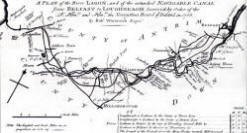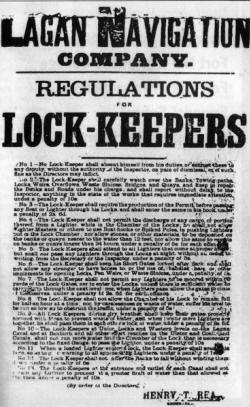
Early days of transportation on the Lagan Canal
 The
vital role of the Lagan in the growth of Lisburn has been well
documented. Here The Digger relates tales from the early days
The
vital role of the Lagan in the growth of Lisburn has been well
documented. Here The Digger relates tales from the early days
"Tom Burrows was a boatman bold,
The length of deck and depth of hold
Of all the craft that made their way,
Beneath the bridge of Ballyskeagh.... ....
His lighter like a duck would swim,
Though slowly, fast enough for him;
She made the run on one fine day,
From Molly Ward's to Lisburn Quay."
These are verses from a poem penned by a 'I. W., Lambeg' dated the 28th December 1826 and related the antics of a lighter man from the Lambeg area.
The poem makes reference to Tom Burrows and his brother Jack transporting thirty tons of Ayrshire coals on the canal. We are informed that Tom had been brought up in the coal trade and owned a lighter that made regular runs between Belfast and Lisburn.
Some 73 years before 'LW.' penned his poem, an Act of Parliament was passed in 1753 in order that the River Lagan would be made fit for the passage of vessels, increasing the trade of Belfast and providing cheaper goods to the surrounding towns and districts. Work began on the canal shortly after that. The initial cost of the construction was defrayed by a local tax on beer and spirits.
The first stage of the Lagan Canal from Belfast to Lisburn was opened on Wednesday 7th September, 1763. The Belfast News Letter reported that on that day, the Lord Hertford Lighter, property of the merchant, Mr Greg(g) made her first voyage to Lisburn with cargo including coals and timber. Guests of Mr. and Mrs.Greg(g) dined on board whilst a band played music.
A bonfire had been lit in the marketplace and a barrel of ale had been given to the populace by Mr. Higginson, Lord Hertford's agent, to toast to their Majesty's health, the prosperity of the Navigation Board and Mr. Omer "who had conducted the works in so masterly a manner." Thomas Omer had been the engineer on the first phase of the canal project.
Liquor, however, was reported to have been instrumental in the death of someone described as "one Smith", who belonged to the Lord Hertford Lighter at Lisburn. It was reported that this person fell overboard and was drowned two days after the official opening on Friday 9th September, 1763.
The grave of Richard Owen at Soldierstown Parish Church. His engineering skills made it possible for the completion of the Lagan Canal project. He died in January 1830.
 By
the early 1780's work had begun on the new section of the canal from
Sprucefield to Lough Neagh. The engineer was Richard Owen who hailed
from Flixton, near Manchester. He had been a pupil of James Brindley the
well known English engineer and had been the engineer on the Leeds and
Liverpool Canal in 1777.
By
the early 1780's work had begun on the new section of the canal from
Sprucefield to Lough Neagh. The engineer was Richard Owen who hailed
from Flixton, near Manchester. He had been a pupil of James Brindley the
well known English engineer and had been the engineer on the Leeds and
Liverpool Canal in 1777.
On Wednesday 1st January 1794, the Belfast Newsletter reported the Commissioners breakfasted at the home of Richard Owen prior to their embarkation at ten o'clock from the aqueduct. They were met with a celebratory "charge of guns" from a boat previously placed along their journey at "Friars Glynn."
It was reported that thousands had turned out on the day and that "refreshments of drink" were copiously distributed. They reached the final lock and at about sunset they were at "Ellis's Cut, in the county of Down" reported at that time to be called "Port Chichester."
We are informed that this late cut from the Union Locks to Lough Neagh is eleven miles long and "7 feet deep, 56 feet wide at the surfaces and 28 at the bottom." The aqueduct consisting of four arches is given a special mention.
We are also informed that it was built of hewn stone and was 300 feet in length and 35 feet high from the foundation. It had been erected on dry ground in order to secure a solid foundation.
The river was then re-coursed and directed under the aqueduct.
Richard Owen was praised for his engineering skill and the Marquis of Donegall for funding the project. "This magnificent undertaking for the benefit of his country will be a lasting monument of his munificence and patriotic attention to the substantial interests of his tenantry and the improvement of Ireland."
From time to time adverts appeared in the Belfast Newsletter relating to various facets of the Canal.
 "The
commissioners for superintending the Lagan navigation meet at the house
of Mr. Alexander McAuley, Innkeeper at Lisburn, on Thursday the 19th
instant, at ten o'clock in the forenoon. Dated 11th Jan 1 769. Signed by
Order James Hudson."
"The
commissioners for superintending the Lagan navigation meet at the house
of Mr. Alexander McAuley, Innkeeper at Lisburn, on Thursday the 19th
instant, at ten o'clock in the forenoon. Dated 11th Jan 1 769. Signed by
Order James Hudson."
The Excise Office in Lisburn advertised later that year that McAuley's premises were to be used for the sale of thirteen snuff rolls of tobacco.
The following advert also appeared: "To Be Sold. On the 2nd of October next at Lisburn. Lighter, the property of Mrs. Agnew, of Mossvale, and Mr. Johnston of Seymour Hill; about 35 tons burthen."
Tuesday 25th September 1798.
The Ordnance Survey Memoirs from the 1830's covering the local districts make many references to the canal system.
"Vessels of from 25 to 30 tons trade up the canal. The charge is 5s per ton for potatoes, oats., etc. They bring timber from Belfast to Tyrone and Armagh coasts, also slates, iron, sugar, coals and tar; in fact anything that will fit in their boat...."
Richard Owen died on the 12th January 1830 in his 87th year at his residence in Moira. A short obituary at the time states "he was eminent and incorruptible as an Engineer, a good neighbour - a sincere friend - a kind relation, and an affectionate husband."
The canal was fully operative at the time of Richard Owen's death and hundreds of lighters annually passed close to his final resting place at Soldierstown Parish Church.
One of the factors instrumental in the successful movement of goods over the years on the canal was the skill and knowledge of lightermen such as Tom Burrows.
For further reading on the subject consult "Once Upon the Lagan - The story of the Lagan Canal" by May Blair.
26/06/2009
